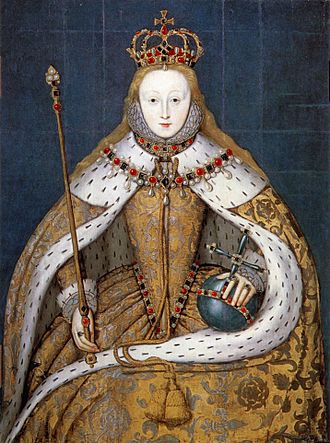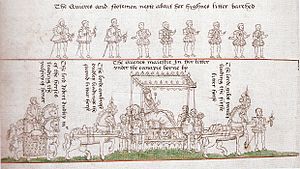Coronation of Elizabeth I facts for kids
Quick facts for kids 
Elizabeth I of England in her coronation robe; a miniature of circa 1600, after a lost original
|
|
| Date | 15 January 1559 |
|---|---|
| Location | Westminster Abbey, London, England |
| Participants |
|
The coronation of Elizabeth I was a super important event! She became the Queen of England and Ireland on January 15, 1559, at Westminster Abbey in London. Elizabeth was 25 years old when she became queen, after her half-sister, Mary I, passed away on November 17, 1558.
This coronation was special because it was the last one in Great Britain to be done under the rules of the Catholic Church. Queen Mary had brought England back to Catholicism, but Elizabeth wanted to bring back the Protestant religion. Historians believe Elizabeth's coronation showed she planned to make England Protestant again, but also keep some Catholic traditions. This mix was later called the Elizabethan Settlement.
Contents
Why Was This Coronation Important?
Elizabeth I's father, Henry VIII, caused big changes in England. He broke away from the Catholic Church and started the Church of England because of his marriage problems. His son, Edward VI, continued these Protestant changes.
But Edward died young in 1553, and Henry's daughter Mary I became queen. She brought England back to Catholicism. Many Protestants were persecuted, and some had to leave the country. Elizabeth, who was Protestant, seemed to go along with Mary's rules. But people who didn't like Mary's government started to look to Elizabeth for hope.
Mary became sick in May 1558 and officially said Elizabeth would be the next queen on November 6. Elizabeth was at Hatfield House when she heard Mary had died on November 17.
Getting Ready for the Big Day
Right after becoming queen, Elizabeth started planning her coronation. She chose a group of people to organize it. They picked Sunday, January 15, 1559, for the big day. This date wasn't a special religious holiday. Instead, it was chosen by her court astrologer, Dr. John Dee, because the stars and planets would be in good positions.
The coronation festivities had four main parts:
- A special trip to the Tower of London.
- A grand parade through the streets of London.
- The coronation ceremony at Westminster Abbey.
- A huge feast at Westminster Hall.
Even though the church ceremony was the main event, Elizabeth knew the parades through London were super important. They would help her become popular with her people. This was a big deal because she was an unmarried woman, and her claim to the throne was a bit tricky. Also, there would likely be more religious changes.
Elizabeth spent a lot of her own money on the coronation. The people of London also gave a huge amount of money to help. This made it a truly English celebration of loyalty to the new queen.
It was hard to find a bishop to lead the coronation service. The main bishop, the archbishop of Canterbury, had died. The next most important one, the archbishop of York, was a Catholic. He agreed to attend but refused to lead the service because of Elizabeth's Protestant changes. Other important bishops were also not suitable or were sick. Finally, a less important bishop, Owen Oglethorpe, was convinced to do it. He had already upset Elizabeth by performing a Catholic ritual during a Christmas church service.
The Grand Parades
The plans for Elizabeth's parades followed an old rule book called the Little Device. This book had been used for many coronations since 1377.
The River Parade
On Thursday, January 12, Elizabeth had a parade on the River Thames. She traveled from Whitehall Palace to the Tower of London. Many boats were decorated beautifully, like a festival in Venice!
The queen rode in her royal barge, which was covered in fancy fabrics. It was pulled by another boat with 40 rowers and a band playing music. As they got close to the Tower, cannons fired a salute.
The City Parade
On Saturday, January 14, Elizabeth had her "royal entry" parade. This was a huge procession from the Tower of London through the City of London to the Palace of Westminster. It even snowed a little that day!
The streets were prepared with barriers to hold back the crowds. Houses were decorated, and the route was lined with members of the City's guilds, carrying flags and banners. It's thought that a thousand horses were part of the procession!
The queen rode in a special chair called a litter. It was covered in white and gold fabric and carried by two mules. Footmen in red cloaks and guards with halberds walked beside her. Many important people were in the parade, including government officials, judges, and nobles.
Along the way, the City had set up eleven special arches and living scenes called "pageants." These showed important messages using symbols. For example, one arch showed a huge rose bush with statues of her family, like Henry VII and Anne Boleyn. This showed that Elizabeth's right to be queen was strong and clear. A small boy explained the meaning of the symbols to the queen, and she listened very carefully.
Near St Paul's Cathedral, there was a very important pageant. It had two fake hills: one looked dry and wasted, the other green and fertile. These showed bad and good ways of ruling. An old man representing "Time" came out of a cave, followed by his daughter "Truth." Truth held a book that said "words of truth" in Latin. This was a banned English translation of the New Testament. Elizabeth kissed the book, thanking the City for this special gift.
At Temple Bar, the queen saw herself shown as Deborah, a judge from the Bible. She was with the three groups of people in England: the nobles, the church leaders, and the common people. This pageant likely showed that the new government would work with Parliament to decide on religious rules. It also helped show that Elizabeth was a strong and rightful ruler, even though some people didn't think a woman should rule.
The Coronation Ceremony
The coronation ceremony happened on Sunday, January 15. The queen entered Westminster Hall early in the morning. Then she walked to Westminster Abbey, surrounded by important nobles. They carried the coronation swords, the orb, and three crowns. The church choir sang a special hymn.
The abbey was decorated with beautiful tapestries. A large platform was built in the middle of the abbey, with steps leading up to St Edward's Chair, where the queen would sit high above everyone. The ceremony followed an old book called the Liber Regalis. This was the last time the service was spoken in Latin before it was translated into English. It was also the last time a Catholic mass was part of the coronation.
The ceremony started with the "Recognition." The people were asked if they accepted Elizabeth as their queen. A witness said they all shouted "Yes!" and the music and bells were so loud "it seemed as if the world were come to an end."
Elizabeth then made an offering and listened to a sermon. The coronation oath was changed slightly to promise to rule according to the "true profession of the Gospel established in this Kingdom." This showed her Protestant intentions. After this came the anointing (where she was blessed with holy oil), the investing (where she received royal clothes and symbols), and finally the actual crowning. Trumpets sounded loudly at this moment!
During the "Homage," the nobles who were not church leaders were the first to promise their loyalty. This was different from tradition, where church leaders usually went first.
The most debated part of the ceremony was the Coronation Mass. Historians aren't sure exactly what happened. It's clear that parts of the service were read in both Latin and English, which was new for a Catholic mass. At some point, Elizabeth went behind a curtained area. Some historians say the bishop leading the service performed a Catholic ritual that Elizabeth didn't like, causing her to leave early. Others say her own chaplain led the mass without that ritual, and she received Holy Communion privately. What is clear is that Elizabeth was careful to show her Protestant leanings while still following some Catholic traditions.
After the ceremony, the queen left the abbey, smiling and greeting the crowd.
The Big Party After!
The coronation feast was held in Westminster Hall. It was decorated with huge tapestries. A special display showed 140 gold and silver cups. About 200 guests sat at four large tables.
The feast began at 3 o'clock. The Duke of Norfolk and the Earl of Arundel, who organized the feast, rode around the hall on horseback! The most exciting part was when the Queen's Champion, Sir Edward Dymoke, rode in wearing a full suit of armour. He made traditional challenges, throwing down his glove to anyone who dared question the queen's right to rule.
The feast ended at 9 o'clock in the evening, and the queen left for Whitehall. A joust planned for the next day had to be postponed because the queen was "feeling rather tired."
What Did This Coronation Mean?
Historians agree that Elizabeth's coronation and the parades were very important. For a long time, people saw them as a clear sign that England was moving away from Catholicism and becoming Protestant.
Today, historians see these events as carefully planned by Elizabeth and her advisors. Even the confusion about what happened during the Coronation Mass shows that the new government's religious plans were still being worked out. It was a clever way for Elizabeth to show her power and intentions without causing too much upset right away.



